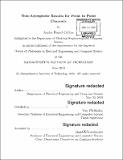| dc.contributor.advisor | Yury Polyanskiy. | en_US |
| dc.contributor.author | Collins, Austin Daniel. | en_US |
| dc.contributor.other | Massachusetts Institute of Technology. Department of Electrical Engineering and Computer Science. | en_US |
| dc.date.accessioned | 2019-11-04T20:21:27Z | |
| dc.date.available | 2019-11-04T20:21:27Z | |
| dc.date.copyright | 2019 | en_US |
| dc.date.issued | 2019 | en_US |
| dc.identifier.uri | https://hdl.handle.net/1721.1/122730 | |
| dc.description | Thesis: Ph. D., Massachusetts Institute of Technology, Department of Electrical Engineering and Computer Science, 2019 | en_US |
| dc.description | Cataloged from PDF version of thesis. | en_US |
| dc.description | Includes bibliographical references (pages 126-128). | en_US |
| dc.description.abstract | This thesis demonstrates some non-asymptotic information theoretic results for point to point channels. Non-asymptotic information theory addresses the question: "For a fixed blocklength and fixed probability of error, what is the maximum number of codewords M that I can support?". Compare this to classical (asymptotic) information theory, which answer this question only for blocklengths tending to infinity and probability of error tending to zero. In this sense, non-asymptotic results are more difficult to derive, but are more practically applicable. First, we look at the multiple input multiple output (MIMO) coherent block fading channel with channel state information available at the receiver, called the MIMO-BF channel. | en_US |
| dc.description.abstract | This is perhaps the most well studied model for a wireless communication channel - it captures the setting where two wireless devices are communicating without a dominant line of sight between them, so the signal reflects off many surfaces before reaching the receiver. A typical example of this channel is communication between two cell phones in a city. The MIMO assumption means the transmitter and receive may have multiple antennas - adding multiple antennas can increase achievable rates enormously while costing very little. This work characterizes the dispersion of the MIMO-BF channel. The dispersion is a fundamental channel quantity similar to capacity - it describes the rate penalty incurred for transmitting at a fixed blocklength and error probability. We first prove achievability and converse theorems, together which demonstrate that the dispersion is given by the conditional variance of the information density, minimized over all capacity achieving input distributions. | en_US |
| dc.description.abstract | We then give an analytic expression for the dispersion, and describe its implications in terms of the channel parameters. For example, we learn that dispersion scales linearly with the coherence time, while capacity is not a function of the coherence time. We then give an achievability bound to help numerically compute the finite blocklength rates, and demonstrate its application to the MIMO-BF channel. Secondly, we analyze the MISO case - where the transmitter has many antennas but the receiver has only one, which turns out to be an interesting special case. For this, we first give a theorem characterizing the input distributions that achieve capacity. It turns out that full 'rate orthogonal design-like input distributions achieve capacity, along with the distribution with i.i.d. Gaussian entries. | en_US |
| dc.description.abstract | It is shown that these orthogonal design objects are in fact the extremal objects of this channel from the point of view of dispersion - using them gives better performance then simply sending independent symbols from each antenna at each time step, a result that cannot be seen with only asymptotic analysis. In this way, orthogonal designs appear as the natural space-time coding scheme for the MISO channel. Finally, we analyze the problem of variable length list decoding with stop feedback. This is the following problem: a transmitter sends symbols one by one into a channel until the decoder says "stop". The decoder then outputs a list of L codewords - if the correct codeword is in the list, it succeeds, else it makes an error. Hence there is a tradeoff between stopping time, number of messages, and the probability of error. | en_US |
| dc.description.abstract | The question becomes: which indicators can tell the decoder that the correct message is in a set of L messages? We demonstrate for the BEC channel that it is possible to communicate with zero dispersion using a variable length list decoding scheme. However for the BSC, surprisingly you cannot stop in a way the gives zero dispersion, when the list size is sub-exponential relative to the number of messages. Furthermore, we show an application to delayed variable length feedback - i.e. the receiver says "stop" but the transmitter only sees the stop signal after a delay, which gives a more practical way of using stop feedback. | en_US |
| dc.description.statementofresponsibility | by Austin Daniel Collins. | en_US |
| dc.format.extent | 128 pages | en_US |
| dc.language.iso | eng | en_US |
| dc.publisher | Massachusetts Institute of Technology | en_US |
| dc.rights | MIT theses are protected by copyright. They may be viewed, downloaded, or printed from this source but further reproduction or distribution in any format is prohibited without written permission. | en_US |
| dc.rights.uri | http://dspace.mit.edu/handle/1721.1/7582 | en_US |
| dc.subject | Electrical Engineering and Computer Science. | en_US |
| dc.title | Non-asymptotic results for point to point channels | en_US |
| dc.type | Thesis | en_US |
| dc.description.degree | Ph. D. | en_US |
| dc.contributor.department | Massachusetts Institute of Technology. Department of Electrical Engineering and Computer Science | en_US |
| dc.identifier.oclc | 1124679388 | en_US |
| dc.description.collection | Ph.D. Massachusetts Institute of Technology, Department of Electrical Engineering and Computer Science | en_US |
| dspace.imported | 2019-11-04T20:21:26Z | en_US |
| mit.thesis.degree | Doctoral | en_US |
| mit.thesis.department | EECS | en_US |
